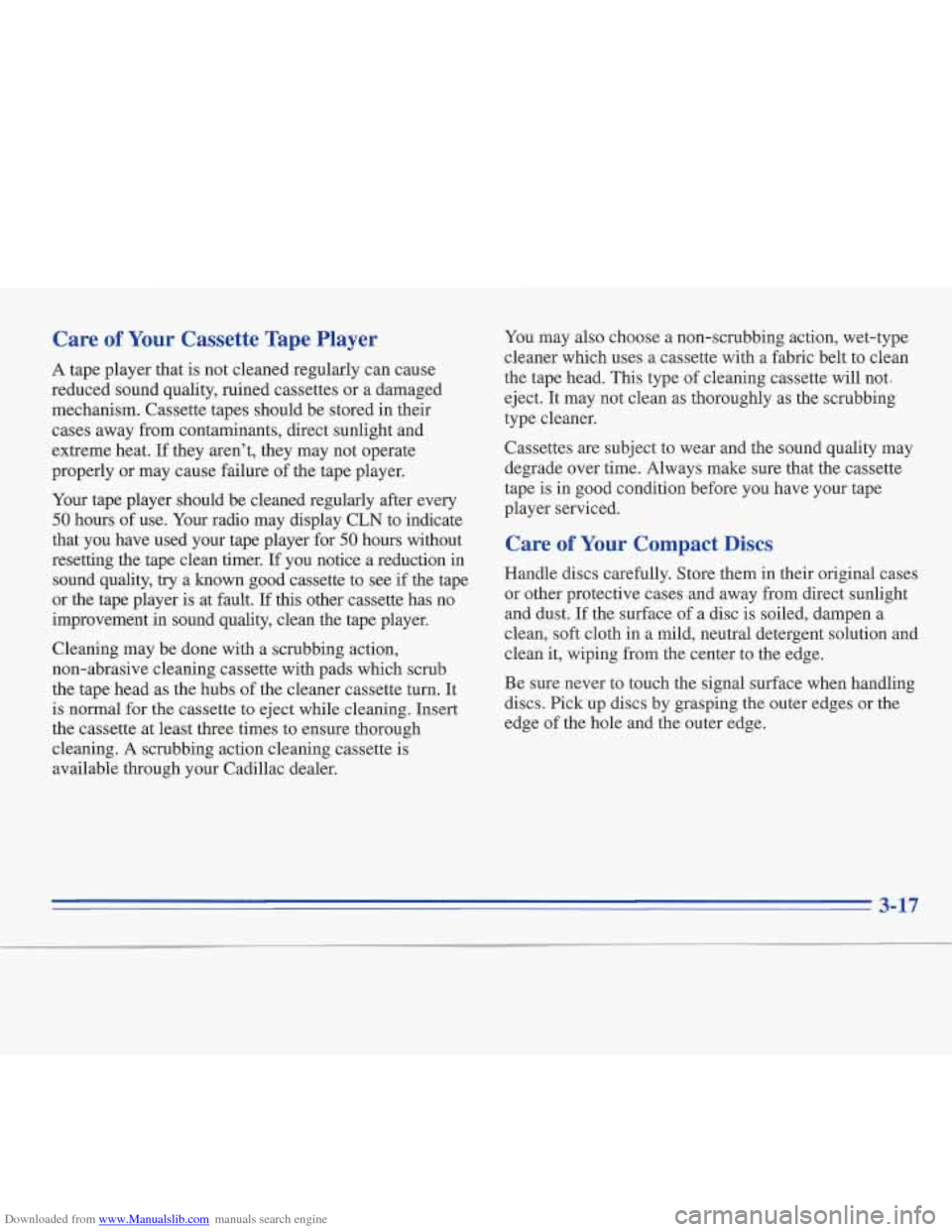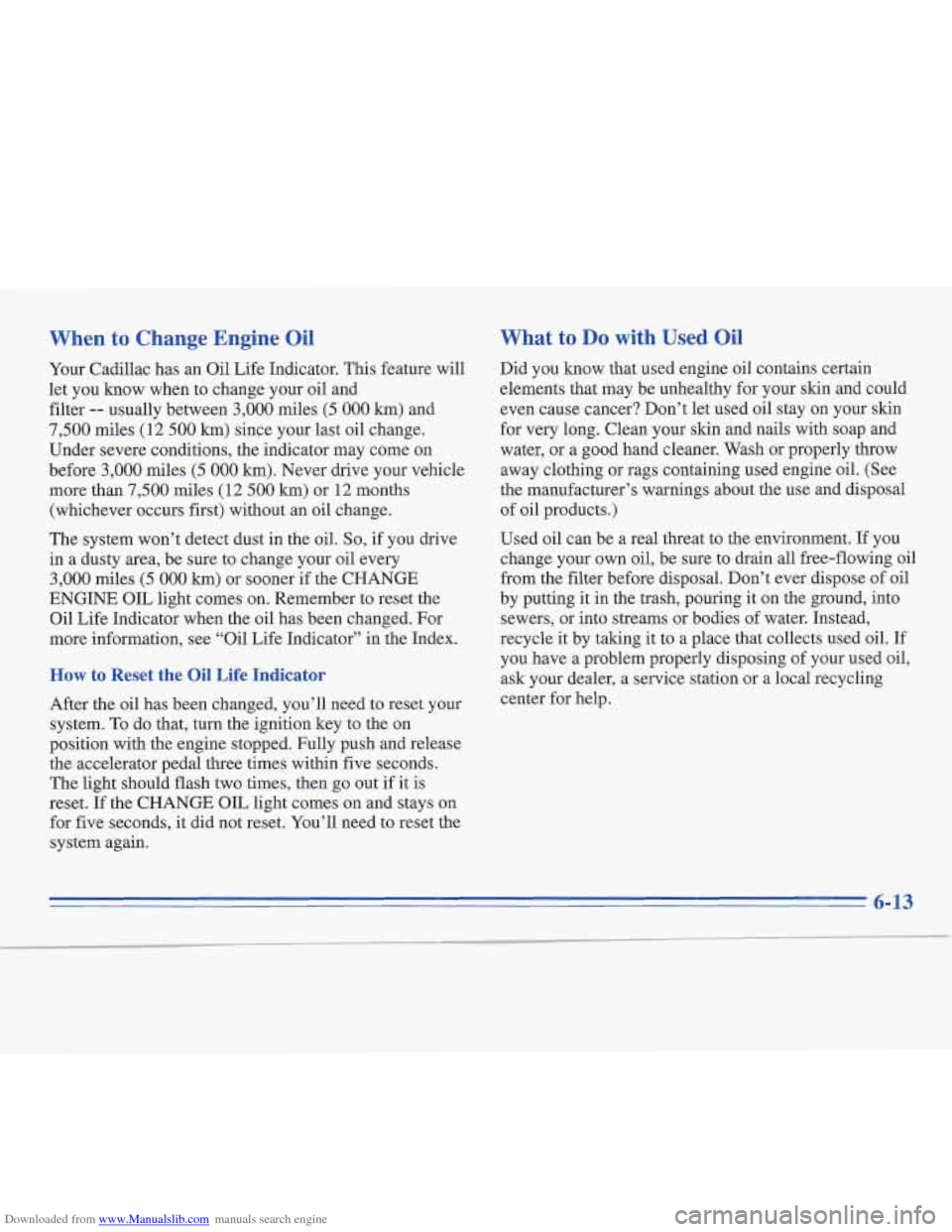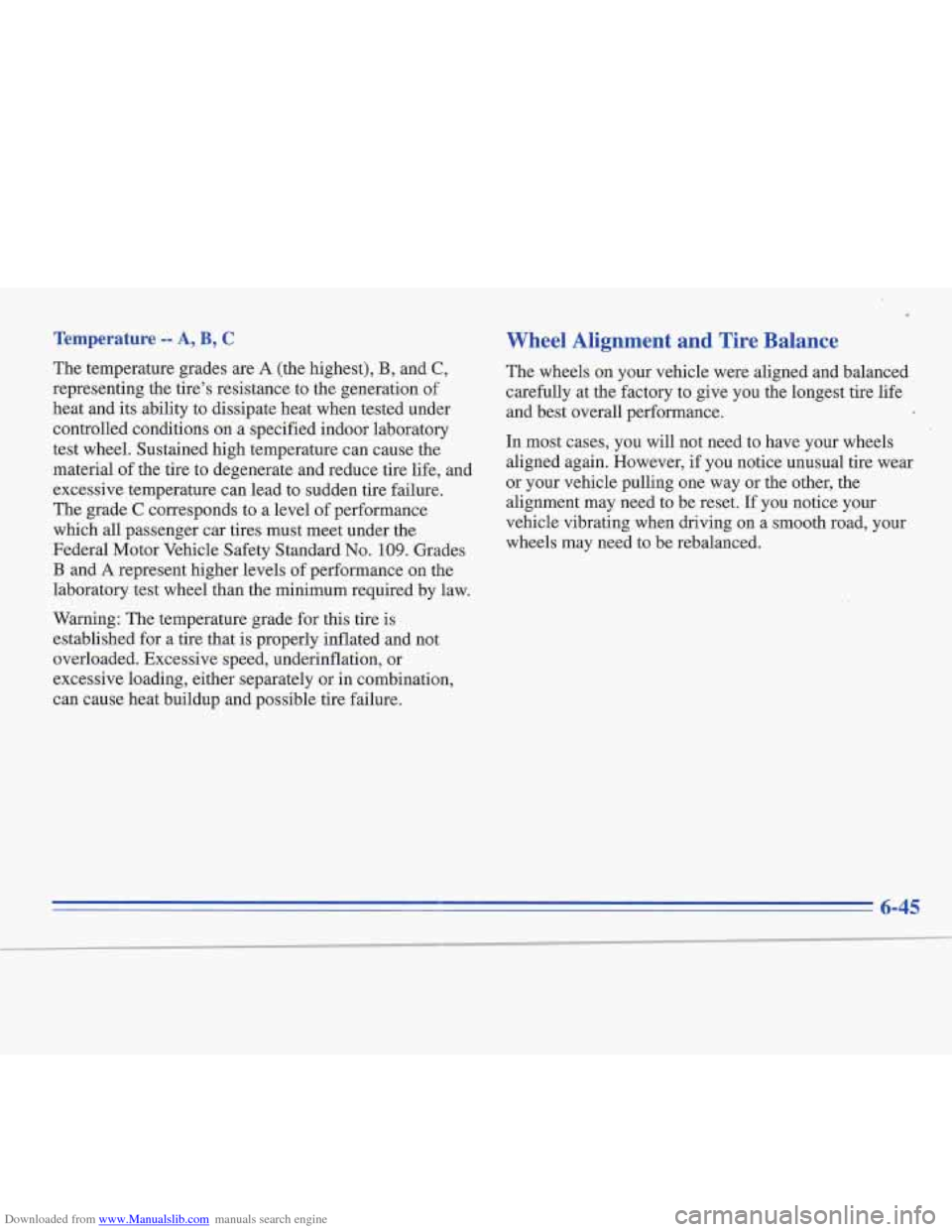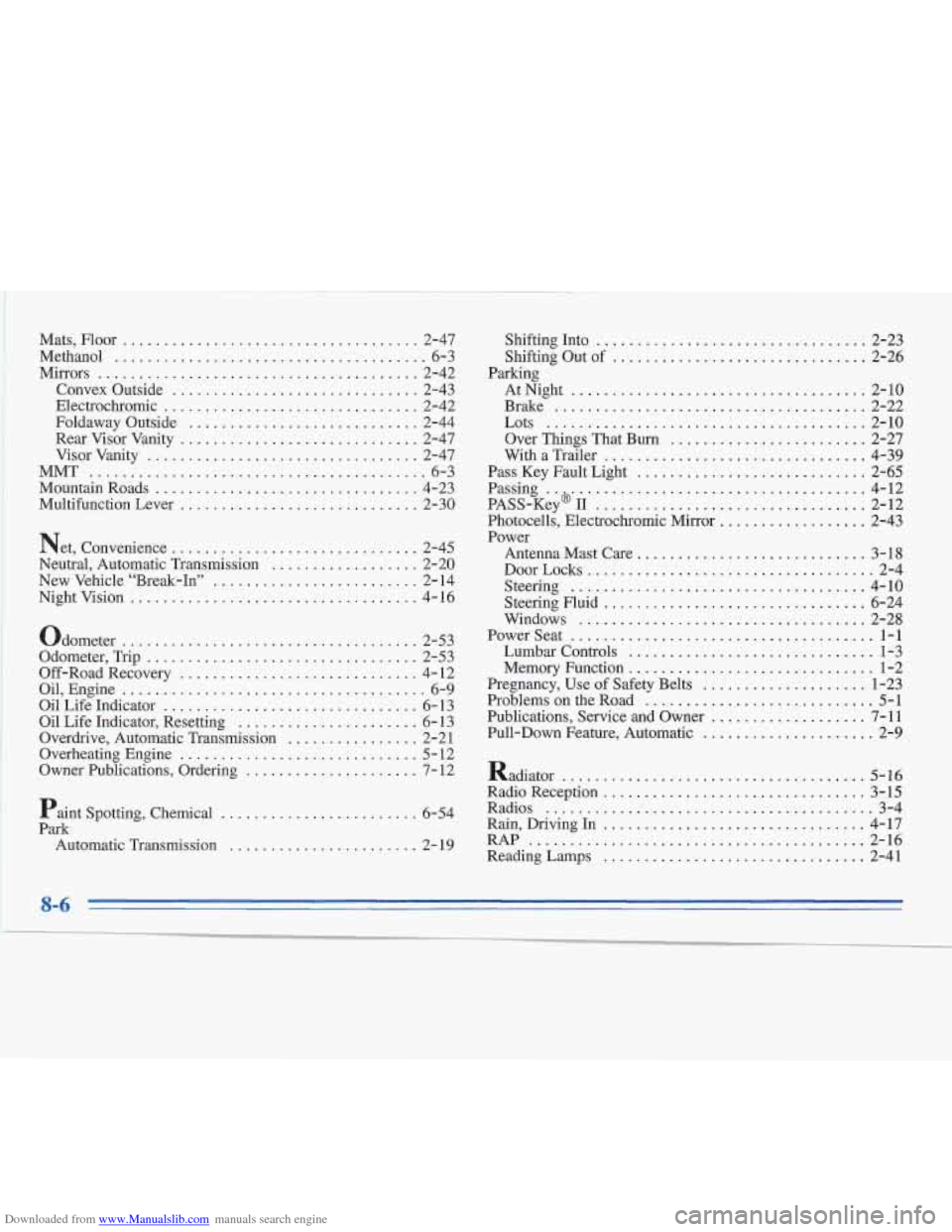1996 CADILLAC FLEETWOOD reset
[x] Cancel search: resetPage 138 of 306

Downloaded from www.Manualslib.com manuals search engine SEEK: Press the up or down arrow to search for the
next or previous selection on the tape. Your tape must
have at least three seconds of silence between each
selection for
SEEK to work. The sound will be muted
while seelung.
SCAN: Press this button to listen to each selection for a
few seconds. The tape will go
to the next selection, stop
for a few seconds, then go to the next selection. Press
SCAN again to stop scanning. The sound will be muted
while scanning and SCAN will appear on the display.
REV (1): Press this button to reverse rapidly to another
part of the tape. Press it again to play the tape. While
reversing the tape, the radio will play. Use the
TUNE
knob to change the radio station while reversing.
FWD (2): Press this button to advance quickly to
another part of
the tape. Press the button again to
play the tape. While forwarding the tape, the radio will
play. Use the TUNE knob to change the radio station
while reversing.
PROG (3): Press this button to change the side of the
tape that is playing.
NR (4): Press this button to reduce background noise.
The double-D symbol will appear on the display. Dolby@ Noise Reduction
is manufacturea unaer a
license
from Dolby Laboratories Licensing Corporation.
Dolby and the double-D symbol
are trademarks of
Dolby Laboratories Licensing Corporation.
AM-FM: Press this button to play the radio when a tape
is playing. The tape will stop but remain in the player.
TAPE: Press this button to change to the tape function
when the radio is active. A box will appear around TP
on the display when the tape is active.
TONE: You can select a TONE setting while playing
a cassette tape and it will be used whenever you play
a tape.
EJECT Press this button to remove the tape. The radio
will play. You may use EJECT with the ignition and
radio
off.
CLN: This message may appear on the display. If it
does, your cassette tape player needs to be cleaned. It
will still play tapes, but you should clean it as soon as
possible to prevent damage to your tapes and player.
See “Care of Your Cassette Tape Player” in the Index.
After you clean the player, press and hold EJECT for
five seconds to reset
the CLN indicator. The radio will
display
--- to show the indicator was reset.
3-11
Page 144 of 306

Downloaded from www.Manualslib.com manuals search engine Care of Your Cassette Tape Player
A tape player that is not cleaned regularly can cause
reduced sound quality, ruined cassettes or a damaged
mechanism. Cassette tapes should be stored
in their
cases away from contaminants, direct sunlight and
extreme heat.
If they aren't, they may not operate
properly or may cause failure of the tape player.
Your tape player should be cleaned regularly after every
50 hours of use. Your radio may display CLN to indicate
that you have used your tape player for
50 hours without
resetting the tape clean timer.
If you notice a reduction in
sound quality,
try a known good cassette to see if the tape
or the tape player is at fault. If
this other cassette has no
improvement in sound quality, clean the tape player.
Cleaning may be done with a scrubbing action,
non-abrasive cleaning cassette with pads which scrub
the tape head as the hubs of the cleaner cassette turn.
It
is normal for the cassette to eject while cleaning. Insert
the cassette at least
three times to ensure thorough
cleaning.
A scrubbing action cleaning cassette is
available through your Cadillac dealer. You
may also choose a non-scrubbing action, wet-type
cleaner which uses a cassette with a fabric belt to clean
the tape head. This type of cleaning cassette will not.
eject. It may not clean as thoroughly as the scrubbing
type cleaner.
Cassettes
are subject to wear and the sound quality may
degrade over time. Always make sure that the cassette
tape is
in good condition before you have your tape
player serviced.
Care of Your Compact Discs
Handle discs carefully. Store them in their original cases
or other protective cases and away from direct sunlight and dust.
If the surface of a disc is soiled, dampen a
clean, soft cloth in a mild, neutral detergent solution and
clean
it, wiping from 'the center to the edge.
Be sure never to touch the signal surface when handling
discs. Pick up discs by grasping the outer edges or the
edge of the hole and the outer edge.
3-17
Page 230 of 306

Downloaded from www.Manualslib.com manuals search engine When to Change Engine Oil
Your Cadillac has an Oil Life Indicator. This feature will
let you know when to change your oil and
filter
-- usually between 3,000 miles (5 000 km) and
7,500 miles (12 500 km) since your last oil change.
Under severe conditions, the indicator may come on
before
3,000 miles (5 000 km). Never drive your vehicle
more than
7,500 miles (12 500 km) or 12 months
(whichever occurs first) without an oil change.
The system won’t detect dust in the oil.
So, if you drive
in a dusty area, be sure to change your oil every
3,000 miles (5 000 krn) or sooner if the CHANGE
ENGINE
OIL light comes on. Remember to reset the
Oil Life Indicator when the oil has been changed. For
more information, see “Oil Life Indicator” in the Index.
How to Reset the Oil Life Indicator
After the oil has been changed, you’ll need to reset your
system. To do that, turn the ignition key to the on
position with the engine stopped. Fully push and release
the accelerator pedal
three times within five seconds.
The light should flash two times, then go out if
it is
reset.
If the CHANGE OIL light comes on and stays on
for five seconds,
it did not reset. You:’Uneed to reset the
system again.
What to Do witL Used Oil
Did you know that used engine oil contains certain
elements that may be unhealthy for your skin and could
even cause cancer? Don’t let used oil stay on your skin
for very long. Clean your skin and nails with soap and
water, or a good hand cleaner. Wash or properly throw
away clothing
or rags containing used engine oil. (See
the manufacturer’s warnings about the use and disposal
of oil products.)
Used oil can be a real threat to the environment. If you
change your own oil, be sure to drain all free-flowing oil
from the filter before disposal. Don’t ever dispose of oil
by putting it in the trash, pouring it on the ground, into
sewers, or into streams or bodies of water. Instead,
recycle it by taking
it to a place that collects used oil, If
you have
a problem properly disposing of your used oil,
ask your dealer, a service station or a local recycling
center for help.
Page 240 of 306

Downloaded from www.Manualslib.com manuals search engine Adding Coolant
If you need more coolant, add the proper mix at the
surge tank, but only when the engine is cool.
I
You can be burned if you spill coolant on hot
engine parts. Coolant contains ethylene glycol,
and
it will burn if the engine parts are hot
enough. Don’t spill coolant on a hot engine.
When replacing the pressure cap, make sure it is tight.
Surge Tank Pressure Cap
NOTICE:
The surge tank pressure cap is a 15 psi (105 kPa)
pressure-type cap and must be tightly installed to
prevent coolant loss and possible engine damage
from overheating.
When you replace the surge tank pressure cap, a GM cap
is recommended.
Thermostat
Engine coolant temperature is controlled by a thermostat
in the engine coolant system. The thermostat stops the
flow of coolant through the radiator until the coolant
reaches a preset temperature.
When you replace your thermostat, an
AC@ thermostat
is recommended.
6-23
Page 262 of 306

Downloaded from www.Manualslib.com manuals search engine Temperature -- A, B, C
The temperature grades are A (the highest), B, and C,
representing the tire’s resistance to the generation of
heat and its ability to dissipate heat when tested under
controlled condtions on a specified indoor laboratory
test wheel. Sustained high temperature can cause the
material of the tire to degenerate and reduce tire life, and
excessive temperature can lead
to sudden tire failure.
The grade
C corresponds to a level of performance
which all passenger car tires must meet under the
Federal Motor Vehicle Safety Standard
No. 109. Grades
B and A represent higher levels of performance on the
laboratory test wheel than the minimum required by law.
Warning: The temperature grade for this tire
is
established for a tire that is properly inflated and not
overloaded. Excessive speed, underinflation, or
excessive loading, either separately or in combination,
can cause heat buildup and possible tire failure.
Wheel Alignment and Tire Balance
The wheels on your vehicle were aligned and balanced
carefully at the factory to give you the longest tire life
and best overall performance.
In most cases, you will not need to have your wheels
aligned again. However, if you notice unusual tire wear
or your vehicle pulling one way or the other, the
alignment may need to be reset. If you notice your
vehicle vibrating when driving on a smooth road, your
wheels may need to be rebalanced.
6-45
Page 301 of 306

Downloaded from www.Manualslib.com manuals search engine Mats. Floor .................................... 2-47
Methanol
...................................... 6-3
Mirrors
....................................... 2-42
Convex Outside
.............................. 2-43
Electrochromic
............................... 2-42
Foldaway Outside
............................ 2-44
Rear Visor Vanity
............................. 2-47
Visor Vanity
................................. 2-47
MMT
......................................... 6-3
MountainRoads
................................ 4-23
Multifunction Lever
............................. 2-30
Net. Convenience
.............................. 2-45
Neutral. Automatic Transmission
.................. 2-20
New Vehicle “Break-In”
......................... 2-14
Nightvision
................................... 4- 16 Shifting Into
................................. 2-23
Shifting Out
of ............................... 2-26
AtNight
.................................... 2-10
Brake
...................................... 2-22
Lots
....................................... 2-10
Over Things That Burn
........................ 2-27
With a Trailer
................................ 4-39
Pass Key Fault Light
............................ 2-65
Passing
..&.................................... 4-12
PASS-Key
I1 ................................. 2-12
Photocells, Electrochromic Mirror
.................. 2-43
Power Antenna Mast Care
............................ 3-18
DoorLocks
................................... 2-4
Steering
.................................... 4-10
Steering Fluid
................................ 6-24
Windows
................................... 2-28
Parking
..................................... Odometer .................................... 2-53
Powerseat 1-1
Odometer, Trip ................................. 2-53 Lumbar Controls 1-3
Off-RoadRecovery
............................. 4-12 Memory Function 1-2
Oil, Engine
..................................... 6-9 Pregnancy, Use of Safety Belts 1-23
Oil Life Indicator
............................... 6-13 Problems on the Road 5-1
Oil Life Indicator, Resetting
...................... 6- 13 Publications, Service and Owner 7-11
Overdrive. Automatic Transmission
................ 2-21 Pull-Down Feature, Automatic 2-9
..............................
..............................
....................
............................
...................
.....................
Overheating Engine ............................. 5- 12
Owner Publications. Ordering
..................... 7- 12
Paint Spotting. Chemical
........................ 6-54
Park Automatic Transmission
....................... 2- 19 Radiator
..................................... 5-16
Radio Reception
................................ 3-15
Rain. Driving In
................................ 4-17
Radios
........................................ 3-4
RAP
......................................... 2-16
ReadingLamps
................................ 2-41
{ 8-6